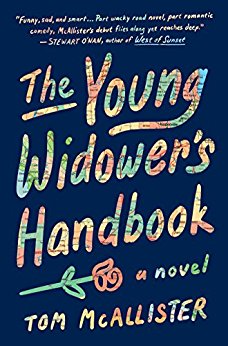The Young Widower’s Handbook: A Novel
- By Tom McAllister
- Algonquin Books
- 288 pp.
- Reviewed by Patricia Ann McNair
- April 5, 2017
A bittersweet, often heartrending story of love lost way too soon.

“You like to think your grief is individual and unique and objectively worse than the rest of the world’s, but the brutal truth is, it is not, and this fact is not as comforting as some people seem to want to believe.”
What is a man — not yet 30 — supposed to do when he is suddenly a widower? When his young, lovely, tough, insecure, previously healthy wife of much too short a time dies without any warning beyond some discomfort, some relentlessly growing pain and nausea?
When the resident in the emergency room says, “We’ll have her back to you soon,” and the nurse, a ridiculously short time later, tells him that he can see the body if he wants?
In Tom McAllister’s first novel, The Young Widower’s Handbook, this is the dilemma — this grappling with what to do in the face of such immense and unexpected grief. Hunter Cady, McAllister’s protagonist, copes with all of this the best way he knows how: by not coping.
Instead, he runs away.
In the first chapter, we are swept along in the fast current of the love affair turned marriage of Hunter and Kait. We watch as they move from their first meeting at a rooftop party to dating that brings them out of their parents’ homes, where they have returned to live after college and before full-on adulthood.
We listen to the stories they tell one another (Hunter tells Kait, mostly) as a means of courtship, as a way of introducing and discovering one another. We understand that Kait wants a ring; she wants to be married (but not like those women who “can’t be happy or self-actualized if they’re unmarried”); and she wants to marry Hunter, the man who begins “laying the groundwork for a lifetime of happiness” for the two of them, only to have it all snatched away on an otherwise unremarkable Wednesday, and burned to ashes by Thursday.
Be warned, this is among the most heartbreaking first chapters in contemporary literature. And, oh! The last line. “She’s dead and she’s dead and she’s dead and she’s dead and she’s dead and she’s never coming back.”
Who would not want to run away from this? And from the immediate aftermath of having his home “infested” with over-eager, sandwich-bearing well-wishers and clumsy, emotionally damaged relatives? Hunter gathers the cube of Kait’s ashes and very little else, and sets off on an extended road trip — a way of pretending that he is taking her on the adventures they always dreamed of sharing, that he is keeping up his side of the marriage bargain that they would “get rich and embark on a perpetual vacation.”
The road trip, of course, is not without its challenges: The car breaks down; Hunter gets drunk with a bachelorette party and his longing makes him lose track of Kait’s ashes; Kait appears to him on the television screen in an episode of a reality show; Hunter’s father tracks him down and scolds him as though he were still a teenager; and his in-laws threaten him with violence and police action because he has taken Kait away from them.
But there is goodness on the road, too. Hunter finds a lost boy and is invited to have a picnic with the boy’s family when they are reunited. “So,” he says, “You guys are like the perfect family, huh?”
But even Hunter can hear the aggression behind that question. And this is what makes this book so very fine — the complications of this young widower’s emotions, the desire to strike out, the pain behind the funny parts, the agony that underscores the absurd.
Structurally, the novel is well made. Some chapters are written as a sort of handbook, just as the title implies: “Say then your wife decides to die on you without any warning…with no experience and no idea how to take care of yourself.
“What do you do now?”
The use of the second person in these chapters draws us more deeply into the story, giving us a sort of sequence and process to follow: You do this and you do this and then you do this. This handbook style is subtle and unobtrusive and is combined with a variety of other narrative devices like lists and texts and phone conversations and Facebook posts marking the journey with photos of Kait in her cube and offhand quips (“Kait, checking out the scenery”) that Hunter’s friends respond to in kind on Facebook: “Dude, WTF LOL!”
All of this, the straightforward scenes, the lists, the posts, the handbook chapters, are then deftly braided with the history of Hunter and Kait, of their individual lives leading up to this time, and of the much-too-short story of their life together.
Victor Hugo wrote to a friend, “Death has its revelations: the great sorrows which open the heart open the mind as well; light comes to us with our grief.”
And, so, no spoilers. We know even before we begin this novel that the wife has died, and we know, too, that there are lessons to be learned from this handbook. Even so, those lessons are not easily come by. Not by Hunter, nor by us.
Patricia Ann McNair is author of And These Are the Good Times, an essay collection forthcoming in September 2017. Her short-story collection, The Temple of Air, was named the Chicago Writers Association’s Book of the Year and won Southern Illinois University’s Devil’s Kitchen Readers Award and a Society of Midland Authors Finalist Award. She teaches creative writing at Columbia College Chicago.

